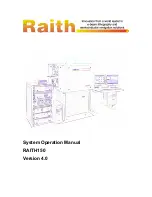
6. Maintenance
6.1 Checkup
Perform checkup and maintenance by taking the following recommended intervals as an indication:
CAUTION
■
Be sure to perform regular checkup of the equipment and components.
Contents
Details
Daily checkup
Verifying LEDs being lit
Verifying state of the turntable
After pressing the timer key with the door opened, verify
lighting of respective LEDs and proper rotation of the
turntable. With any failure existing, a curing defect occurs.
(For details, see Section 4.5, “Startup and checkup.”)
Checking the lens cover for
contamination
Clean the lens cover if contaminated.
(See Section 6.2, “Cleaning and replacement of respective
portions.”)
Weekly checkup
Whether the connections are sound
Verify the sound connection of the AC adapter and power
cord, and check them for accumulation of dust.
Checking the step mode switch for
contamination
Clean the step mode switch if attached with dust and dirt.
(See Section 6.2, “Cleaning and replacement of respective
portions.”)
Checking inside the curing chamber
for contamination
Clean the curing chamber if contaminated.
(See Section 6.2, “Cleaning and replacement of respective
portions.”)
Parts replacement
Replacing the lens cover
(Replacement interval as an
indication: 1 year *depends on
frequency of usage)
Heavy discoloration, contamination or scratches of the lens
might result in a curing defect. When checkup of the lens
cover is performed and find discoloration, contamination or
scratches which cannot be cleaned, replace the lens cover.
* Lens cover potentially be discolored by aging.
(See Section 6.2, “Cleaning and replacement of respective
portions.”)
CAUTION
■
Be sure to clean the curing chamber regularly, as otherwise, the contaminated chamber could not exercise
suffi cient curing performance. If fl ammable disinfectant is used (e.g. Isopropyl alcohol based), there is risk
of ignition/explosion if lamp is started with vapors in the chamber.
Note
●
In case a LED unit fails, other LED units can still properly irradiate light. However, as the total amount of
light is reduced, the curing time should be extended and curing status should be suffi ciently monitored.
The failed LED unit should be promptly repaired.
6.2 Cleaning and Replacement of parts
Be sure to plug off the power cord so that the unit is not activated during cleaning or replacement work.
CAUTION
■
Maintenance, if intended after a prolonged use, should be conducted after the unit temperature suffi ciently
lowers.
EN
EN 21
2) A prosthesis or artifi cial tooth with a height of 52mm or less placed on a model
Use “Curing plate” and “Curing stand holder”
70mm
52mm
70mm directly
(Recommended curing position)
3) A prosthesis or artifi cial tooth with a height of 52mm or more placed on a model
Place it together with the model on the turntable.
Note
●
When placing an object subject to curing outside the recommended curing range, set curing time rather
larger since light may not suffi ciently shine on the object.
●
Care should be taken that if a prosthesis or model placed outside the 100mm outer diameter of the
turntable or higher than 80mm, interference of the object subject to curing or model with the visor or the
curing chamber wall occurs, thereby causing improper or unable rotation of the turntable.
5.4 Use method of the Curing stand set
For a prosthesis alone, such as crown and bridge, or that placed on a model equipped with dowel pin, set it in
combination with the curing stand and various posts by referring to the following examples of use.
Clip
Round hole
Hexagonal hole
Three consecutive
round hole
Curing stand
Fixes a prosthesis and inserted into a round hole or three
consecutive round holes provided on the curing stand.
Metal post
Receives a prosthesis and inserted into a round hole or three
consecutive round holes provided on the curing stand.
Silicone post
Receives a prosthesis and inserted into a hexagonal hole
provided on the curing stand. Cut the protrusion for use, as
needed.
Prosthesis placed on a model equipped with a dowel pin
The model with a prosthesis thereon is placed on the curing stand by inserting the dowel pin into the
hexagonal hole provided on the stand.
EN 20
Summary of Contents for Labolight DUO
Page 2: ......
Page 5: ...EN EN 3...
Page 33: ...DE DE 3...
Page 61: ...FR FR 3...
Page 88: ......
Page 91: ...IT IT 3...
Page 119: ...ES ES 3...
Page 146: ......
Page 149: ...PL PL 3...
















































